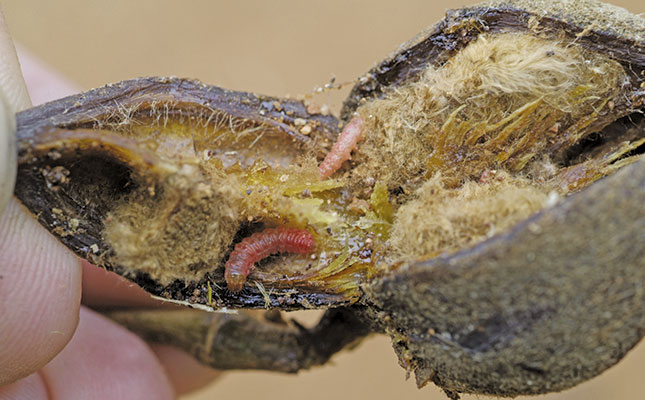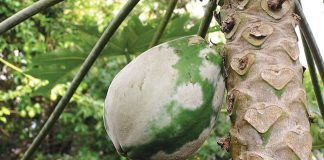
Scientific name: Thaumatotibia (Cryptophlebia) leucotreta
Family: Tortricidae
Distribution: Primarily throughout Africa and Europe.
It attacks fruit at all stages of its development. If this occurs early on, the fruit may ripen prematurely and drop off. Amongst the many crops targeted are avocados, beans, coffee, cotton, grapes, macadamias, maize and tomatoes. Most moths of this genus have a similar appearance and characteristics. The wings are patterned with greys, light browns, creams, blacks and orange browns, and have a span of 1,5cm to 2cm. Adults seldom venture far from their birth site, perhaps ranging no more than 100m or so, and are nocturnal. Females attract males by releasing sex pheromones (chemicals that trigger a mating response in the males) into the air.
Reproduction
Females lay three to eight eggs, each about 1mm in diameter, on the surface of the fruit. When laid they are creamy-white, but turn pinkish before hatching. This can take from two days to three weeks, depending on the temperature. As they hatch, the caterpillars bore into the fruit, leaving a discolouration. Once inside, they feed on the soft pulp, which creates mushiness in the fruit. As they mature, they tunnel deeper into the fruit.
In addition to this internal damage, the holes on the surface caused by the caterpillar expose the fruit to disease and mould.
On reaching maturity two to eight weeks later, the caterpillar drops to the ground on a silken thread. It is pinkish and 1,5cm to 2cm long. It spins a cocoon in the soil and remains here for up to six weeks, depending on temperature, before metamorphosing into an adult.
Control measures
Many methods are used to control the false codling moth: chemical, microbial, sanitation, destruction of the host plant, biological, and irradiation. There have been reports of widespread resistance to many of the commonly used insecticides. Pheromone traps are widely employed, as are light traps. All fallen fruit should be collected and destroyed, not simply left to rot. Some growers flood their orchards in winter to kill the pupae.
Natural enemies
Two wasp species, Anagyrus cuthbertsonii and Trichogrammatoidea cryptophlebia control moth populations. But studies have shown that, on their own, these wasps are unable to keep moth numbers manageable. The solution for producers is therefore to combine natural predators with other biological control methods, such as the sterile insect technique (SIT). This involves releasing large numbers of sterile males into the land; if they mate with females, no offspring result. Although effective in controlling small populations, SIT is ineffective against large, dense populations.
Promising research is taking place at Rhodes University in Grahamstown. Here, researchers have isolated a virus from the digestive tract of the moth that can reduce its appetite and cause mutations.
Note: this series is intended as a guide to identifying pests. The control methods discussed are merely suggestions. For help with area- or crop-specific measures, consult your agricultural extension officer.
Paul Donovan, a biologist, advises farmers on pest control.













